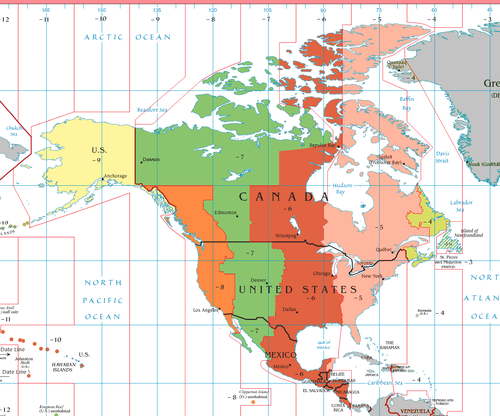| Central Time Zone | |
|---|---|
| Time zone | |
 Central Standard Time Note that most of Mexico abolished DST | |
| UTC offset | |
| CST | UTC−06:00 |
| CDT | UTC−05:00 |
| Current time | |
| 05:58, 25 November 2025CST[refresh] | |
| Observance ofDST | |
| DST is observed in some of this time zone. | |
TheCentral Time Zone is atime zone in parts ofCanada, theUnited States,Mexico,Central America, and a fewCaribbean islands.[1] It is one hour behind theEastern Time Zone.
Daylight saving time is observed in most parts of that zone (20 states in the US, three provinces or territories in Canada, and several border municipalities in Mexico):Central Standard Time (CST) is observed from the first Sunday in November to the second Sunday in March. It issix hours behindCoordinated Universal Time (UTC) and designated internationally as UTC−6.[2] From the second Sunday in March to the first Sunday in November the same areas observedaylight saving time (DST), creating the designation ofCentral Daylight Time (CDT), which isfive hours behind UTC and known internationally as UTC−5.[3]
The province ofManitoba is the onlyprovince or territory in Canada that observes Central Time in all areas.
The following Canadian provinces and territories observe Central Time in the areas noted, while their other areas observeEastern Time:
Also, most of the province ofSaskatchewan is on Central Standard Time year-round, never adjusting for Daylight Saving Time. One major exception includesLloydminster, a city whose borders overlap bothAlberta and Saskatchewan. The city charter[4] stipulates that it shall observeMountain Time and DST, putting the community on the same time as all of Alberta (UTC−7) in the winter, and in time with Saskatchewan (UTC−6) during the summer.
Ten states are contained entirely in the Central Time Zone:
Five states are split between the Central Time Zone and theMountain Time Zone:
Five states are split between the Central Time Zone and theEastern Time Zone:
Additionally,Phenix City, Alabama, and several nearby communities inRussell County, Alabama, unofficially observe Eastern Time. This is due to their close proximity toColumbus, Georgia, which is on Eastern Time.[5]
Although legally located within the Central Time Zone,Kenton, Oklahoma—located to the adjacent east of the defined border of the Central and Mountain time zones (at the Oklahoma−New Mexico state line)—unofficially observes Mountain Time.[6] This is reportedly because most people who interact with the town reside in either New Mexico orColorado.[6][7]
Most of Mexico—roughly the eastern three-fourths—lies in the Central Time Zone, except forfive northwestern states (Baja California,Baja California Sur,Sinaloa,Sonora, and most ofNayarit) and one southeastern state (Quintana Roo). It is known locally as theZona Centro.[8]
The federal entities ofMexico that observe Central Time:
Out of the seven countries comprisingCentral America, all but one use Central Standard Time year-round:
Panama, which recognizes Eastern Standard Time (UTC−5) year round, is the exception.[10]
Daylight saving time (DST) is in effect in much of the Central time zone between mid-March and early November. The modified time is called "Central Daylight Time" (CDT) and isUTC−05:00.[citation needed]
In the United States, all time zones that observe DST were effectively changed by theEnergy Policy Act of 2005. Beginning in 2007, DST would now begin at 2 a.m. (02:00) on the second Sunday in March instead of the first Sunday in April, moving the time from 2 to 3 a.m. (i.e., from 02:00 to 03:00). Additionally, DST would end at 2 a.m. (02:00) on the first Sunday in November instead of the last Sunday in October, moving the time from 2 to 1 a.m. (i.e., from 02:00 to 01:00).[citation needed]
At the time, Mexico decided not to go along withthis change and observed theirhorario de verano ("summer schedule") from the first Sunday in April to the last Sunday in October. In December 2009, the Mexican Congress allowed ten border cities, eight of which are in states that observe Central Time, to adopt the US daylight time schedule effective in 2010. In October 2022, however, CDT was used in Mexico for the last time after DST was abolished. The US is also seeing traction in the same direction, with theSunshine Protection Act that proposes legislation that would permanently end the switching of times and make daylight saving time permanent.[11]